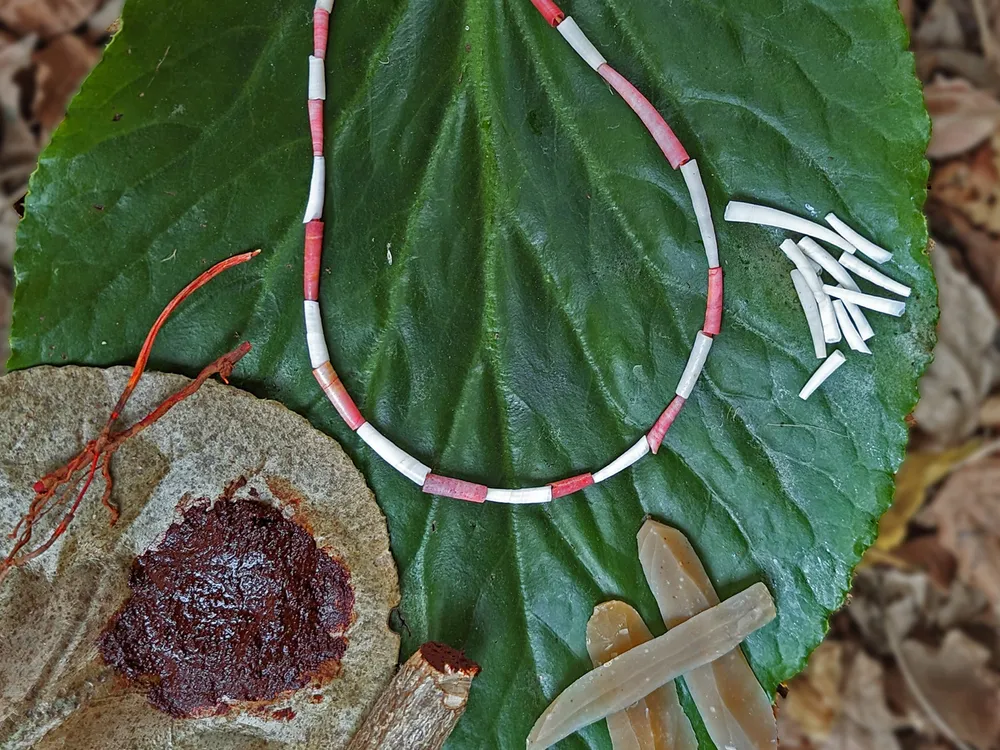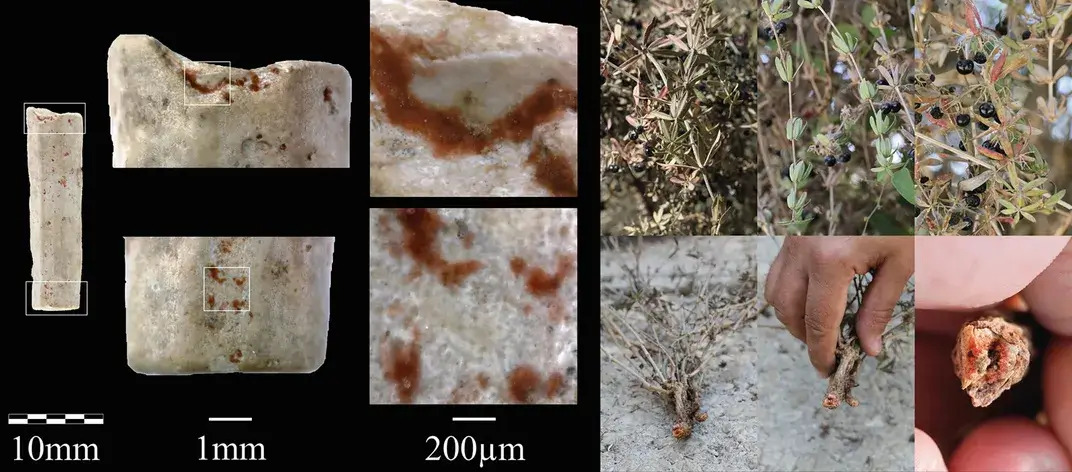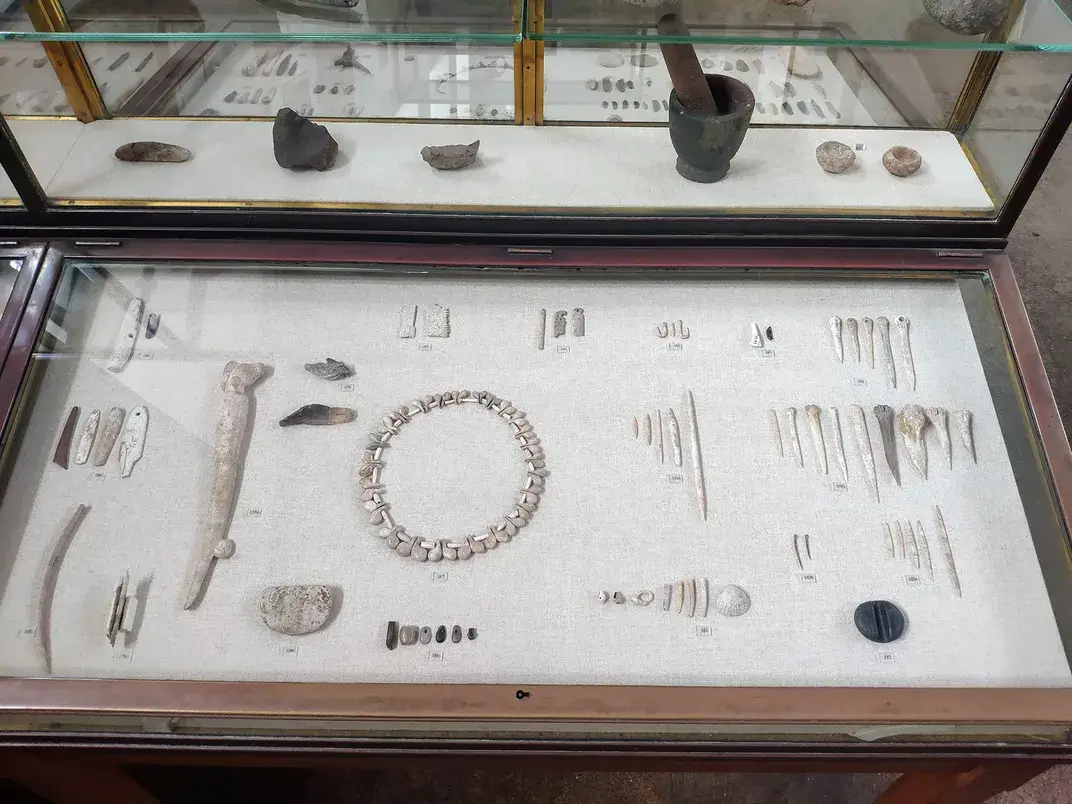
Archaeologists Find The First Red Paint Made From Plants
Hunter-gatherers cooked up the alluring pigment in the Eastern Mediterranean 15,000 years ago
By: Brian Handwerk | Smithsonian
The flash of bright red caught Laurent Davin’s eye. He was looking at an array of 15,000-year-old shell beads and other artefacts, which have been displayed in a case at Jerusalem’s Rockefeller Archaeological Museum since before World War II. Many people had viewed them, but Davin was struck by this detail. “If you look at it, it’s like blood, a really vivid red,” he says, “and I had to wonder, ‘What’s that colour?’”
Countless prehistoric artefacts are coloured red with ochre, a mineral product that was the world’s first red paint, but something made this hue look very different—and Davin set out to discover what it was.
Analysis with high-tech spectroscopy techniques revealed a novel source behind Davin’s suspicions. The beads, originally found in Kebara Cave, on Israel’s Mount Carmel, are the oldest known example of humans using plants to manufacture red pigment. The bright red colour adorning them was produced from the roots of Rubiaceae plants, commonly known as the madder family, according to research published Wednesday in PLOS One.
The creators of this 15,000-year-old paint were part of the Natufian culture. They were the first hunter-gatherers to start settling down to more sedentary lifestyles across the Levant, in what is now Israel, Jordan, Lebanon, Syria and the Palestinian territories. They utilized wild plants for much more than food, including processing them to make pigment, before they domesticated them. The ornamental use of these organic dyes may be an example of a growing need for expression as human societies gradually shifted over the centuries. “You try to look at your environment differently, and you have time to look at it differently, so probably over a long period of time they were looking at things like plants and animals differently and learning a lot,” says Davin, an archaeologist at the Hebrew University of Jerusalem and at a prehistoric technology laboratory at the French National Centre for Scientific Research.
The shell beads originated in the Mediterranean Sea—some from just 10 miles away from Mount Carmel, and some from much farther afield in the Red Sea, around 250 miles away. But many of the beads from Kebara Cave are now located even further away. British archaeologists first undertook excavations at the site in the 1930s and sent many artefacts to museum collections around the world.

Previously, the earliest known examples of plant-based red pigment had appeared around 6,000 years ago. But humans—and our relatives—have long expressed ourselves with the colour red, which appears to have psychological impacts on the human mind. Our ancestors produced pigments from rocks and minerals like iron oxide (which is contained in red ochre) and used them to colour everything from stones and bones to cave walls—with first uses documented in Africa as far back as 500,000 years ago. Shell tooth and bone ornaments in Kebara Cave were also coloured with ochre. Blocks of it were found at the cave, along with ochre-adorned artefacts such as beads and burial textiles, making it clear that this older colour was still very commonly used.
But the Natufian culture may have used the new plant-based red colour to grab attention. What messages or meanings the bright red pigment’s ornamental use might have conveyed are lost in time. But the ways Natufian people expressed themselves creatively represent a distinct shift from older cultures in the region, Davin says. Where older sites might yield a few hundred beads, he explains, Natufian sites have many thousands, in a wide diversity of materials—bone, teeth, shell, clay and even feathers. “Probably it means that their need to express their identity is really different from previous periods,” he says. “Probably they wanted to add something more, another message, another meaning, and probably the use the organic red pigment is part of that.”

Davin and colleagues unearthed the pigment’s plant origins by performing several analyses. Advanced scanning studies showed no iron in the pigment, ruling out an ochre source, but showed a high carbon content that instead pointed to an organic origin. To narrow down exactly what that was, the team then used Raman spectroscopy, a chemical analysis that observes how a substance scatters light, to characterize its molecular composition. The Raman spectroscopy patterns produced by the dye were the same across all ten beads, and among possible candidate species they most closely matched signatures from compounds isolated from roots of plants from the Rubiaceae family—already known from prehistoric pollen analysis to have grown at Mount Carmel during the end of the Pleistocene period.
Oldest Human Ancestors May Have Evolved Nine Million Years Ago In Turkey
The Natufians’ exact recipe for producing the pigment isn’t known, and Davin and his team hope to try their hand at reproducing similar substances with ancient techniques. They theorize that the Natufians dug up plants, cleaned and dried their roots, crushed them, and boiled them in water to dissolve the dye, which was then fermented.
Their use of madder was a very good choice, and one that was often repeated later in history because of the outstanding colour that can be produced by its roots. Red pigments made with madder have been found in King Tut’s tomb, on the Shroud of Turin and in the paintings of Vincent van Gogh. This red was a go-to up until organics were largely replaced by synthetic pigments in the 19th century.
The transition from hunter-gatherer lifestyles to settled agriculture wasn’t a sudden change but a long and gradual process that began with more intensive plant gathering as early as 23,000 years ago. Wild plants were also exploited and cultivated for thousands of years before they became fully domesticated and thus dependent on humans. The production of pigments is another example of how the relationships between people and plants changed, and became more intertwined, during that period.
Natufian culture foragers living between 11,650 and 15,000 years ago were in the late stages of a hunter-gatherer lifestyle and extensively harvesting wild cereal plants for food. Previous research has shown that hunter-gatherers and early agriculturalists also used plants as key sources for making clothing, baskets, string and ornaments. Some of the earliest cultivar plants, like flax, were likely used primarily to make clothes. While non-food plant use was likely widespread, the hard evidence for it remains relatively scarce. Plant products and organic materials simply haven’t stood the test of time, fading away after so many thousands of years.
“People weren’t just hunting animals and eating raw meat. They really were already knowing very well what plants could do and what they could use them for,” says Tobias Richter, an archaeologist at the University of Copenhagen who was not involved in the new study. Richter believes that we probably underestimate Stone Age humans’ knowledge of how to use their landscape. “I think these people were absolute experts in knowing what to do with plants,” he says.
Hundreds of artefacts from Kebara Cave, including bone pendants, teeth, beads and more, were sent to museums across the United Kingdom and North America. Almost all of them, like artefacts from many other sites, have never been analysed to see what types of plant- or animal-based pigments and dyes they might display. Using such techniques to delve into their origins could reveal much more about early relationships between humans and other species.
Davin also hopes that future research will shed further light on the domestication of plants. Tools from the Kebara Cave could hold residues from processing plants, and that residue could yield genetic material. With enough samples, scientists could analyse the ancient genome and compare it to modern plants to trace the history of madder plant domestication. Beyond these species’ longstanding role as a source of pigment, their stems and leaves are still prized in the region, including in neighbouring Jordan, for their antioxidant, antibacterial and even aphrodisiac qualities.
To Richter, the plant-based pigments are another clear example that humans were using their imaginations to explore the resources available to them, and then used those resources creatively to elaborate their own ornamentations and rituals.
“I think we tend to imagine the Stone Age past to be sort of bleak and rough and difficult to survive,” he says. “But it was also a lot more colourful and a lot more diverse than I think we often give it credit for.”
* * *
NEXT UP!
7,000-Year-Old Native American ‘Bog Burial’ Found Off The Coast of Florida
The 167 bodies discovered in a pond in Windover, Florida started to stir up excitement in the archaeological world only after the bones were declared very old, and not the product of mass murder. Researchers from Florida State University came to the site, believing that in the swampland some more Native American bones had been found.
They believed the bones were between 500 and 600 years old. But then the bones were dated with radiocarbon. It turns out that these corpses were between 6,990 and 8,120 years old. The academic community was then incredibly excited. Windover Bog has proved to be one of the United States’ most significant archaeological discoveries.
In 1982, Steve Vanderjagt, the man who made the discovered, was using a backhoe to demolish the pond to create a new subdivision between Disney World and Cape Canaveral. A large number of rocks in the pond confused Vanderjagt since the region of Florida was not considered to be particularly rocky.
* * *
READ MORE: Analysis of Ancient Teeth Questions Theory That Native Americans Originated From Japan
Interesting! Monument of Native American Hero “Crazy Horse” Slowly Taking Shape In South Dakota
Enjoyed it? Please take a moment to show your support for Collective Spark.
We’d love to hear from you! If you have a comment about this article or if you have a tip for a future Collective Spark Story please let us know below in the comment section.
